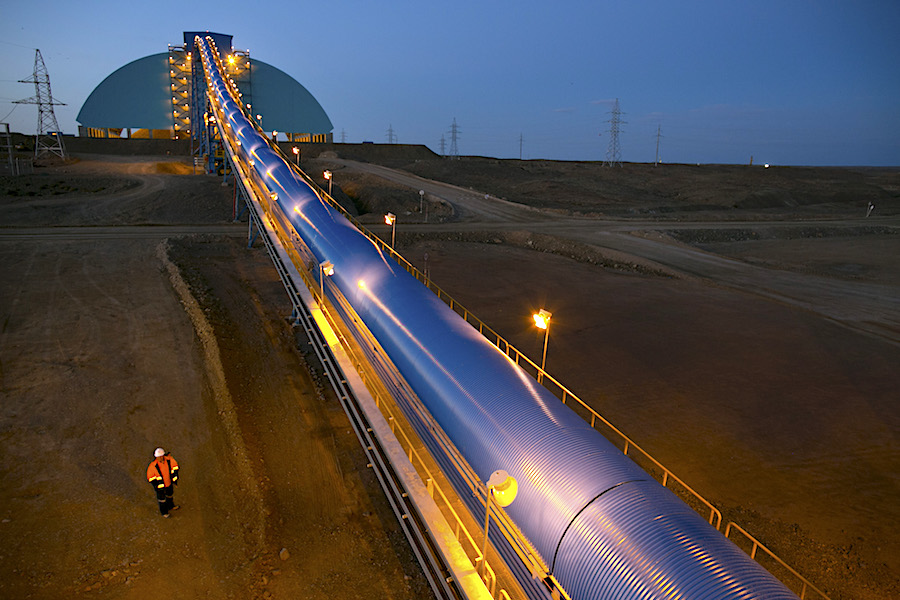
Jakob Stausholm will have to pick up a travel guide to Ulaanbaatar. Rio Tinto’s new chief executive has a challenging to-do list and atop it sits the miner’s troubled $10 billion Oyu Tolgoi copper and gold project, located 700 kilometres from the Mongolian capital. Trying to satisfy all the interested parties at once is probably a fool’s errand.
It’s surprising the whole sticky mess, along with the high tensions between Australia and China and Rio’s frayed relations with indigenous peoples, didn’t dissuade Stausholm from taking the job. Turquoise Hill Resources, the Canadian-listed company that owns two-thirds of Oyu Tolgoi, lost a fifth of its market value on Jan. 11 after suggestions that the Mongolian government might not continue with the project. Shares of Turquoise, in which Rio holds a 51% stake, have tumbled by two-thirds since 2016.
Oyu Tolgoi should be a real asset. It is expected to churn out 500,000 tonnes of copper annually later this decade. That would make it the world’s fourth biggest producer. And prices for the red metal have soared 70% since March and should stay high as demand for electricity, and therefore copper wiring, soars.
RELATED: Stakes high for Rio Tinto, Mongolia as Oyu Tolgoi talks loom
The project, however, is hamstrung by a rickety corporate structure and a major funding problem. Big digs typically involve private-sector entities owning the equity, with generous annual royalties paid to the host state’s exchequer. Aside from Rio, Oyu Tolgoi has three main stakeholders: the state, the non-Mongolian minority shareholders who own 49% of Turquoise, and Odey Asset Management, a pushy British hedge fund that is a Rio investor and has a short position in Turquoise. Ulaanbaatar holds 34% of Oyu Tolgoi LLC, and Turquoise owns the rest.
The main headache is that Mongolia, with a GDP of just $14 billion and limited cash, has long funded its portion of the project’s capital investment with loans from Turquoise
The main headache is that Mongolia, with a GDP of just $14 billion and limited cash, has long funded its portion of the project’s capital investment with loans from Turquoise. It represents a big chunk of the $7 billion advanced to Oyu Tolgoi over the last decade, according to company disclosures, at an annual interest rate of 6.5 percentage points above the London Interbank Offered Rate. It also borrowed another $1.3 billion from Turquoise to finance its Oyu Tolgoi share purchases. This all must be repaid before Mongolia can receive dividends. Even if the project had been on time and budget, Ulaanbaatar would have faced a long wait.
As it is, the project costs recently jumped sharply to $6.75 billion, so any payouts could take decades. Unsurprisingly, that’s causing a political stink in Mongolia. Meanwhile, Turquoise faces a funding gap of at least $3 billion between the point in 2022 when its remaining $1.3 billion of cash runs out, and the date a few years later when Oyu Tolgoi’s main underground phase starts throwing off cash.
Stausholm can choose between an incremental solution and a radical one. The former, favoured by some Turquoise minority shareholders, would deploy various measures to plug the funding gap. Extending the maturity on about a third of the $4.4 billion in financing Oyu Tolgoi obtained from international lenders in 2015 would reduce servicing costs. Issuing other debt, pre-selling some of the mine’s metal, and higher copper price assumptions would do the rest.
Odey prefers a bolder approach. Rather than increase Turquoise’s debt, it thinks Rio should push for a big rights issue. That makes sense insofar as the $3 billion funding gap might actually increase if Turquoise ends up having to pay for a power station to provide the mine’s energy, which is currently provided by China. But given that Turquoise’s market capitalisation is less than $2.5 billion, any investors that didn’t take part in the equity raise would be heavily diluted.
Stausholm won’t be eager to antagonise Turquoise’s minority shareholders, nor put still more of his company’s money into an Oyu Tolgoi-related capital call. With minimal net debt, however, Rio is in a position to push for the most sustainable long-term solution. His company already guarantees the $4.4 billion project finance facility and consolidates the $8.3 billion of loans. An equity hike would leave Rio with more of the project’s cash flows without increasing the debt it underwrites.
Rio’s boss also needs to tread carefully around Ulaanbaatar. Mongolia’s nuclear option would be to dismiss the $140 billion miner from the project and bring in one of its rivals instead. Tearing up such a high-profile contract might hurt foreign investment flows into the country, but Oyu Tolgoi’s significance could make it worth the risk. In addition to solving the funding gap, the host country wants more cash from the mine it feels it owns.
Stausholm’s least-bad strategy therefore probably has two strands. First, Rio should back an equity hike to plug the funding gap. If Turquoise’s minority shareholders are optimistic about Oyu Tolgoi, they should be ready to support a rights issue.
Second, Stausholm should rework the loan structure to appease Mongolia. One option is to put 75% of the cash that Oyu Tolgoi generates toward reducing debt and use the rest for payouts to Ulaanbaatar. It might even take a 50-50 split to ease relations between miner and state. Under this approach, along with having to answer to angry Turquoise owners, Rio might take a financial hit. But it is likely to do so in almost any solution.
There’s no way for Stausholm to make everyone happy. As the new broom, he at least has a freer hand compared to his predecessor Jean-Sebastien Jacques, who was so closely associated with the project. He may as well use it.
(By George Hay)
Comments